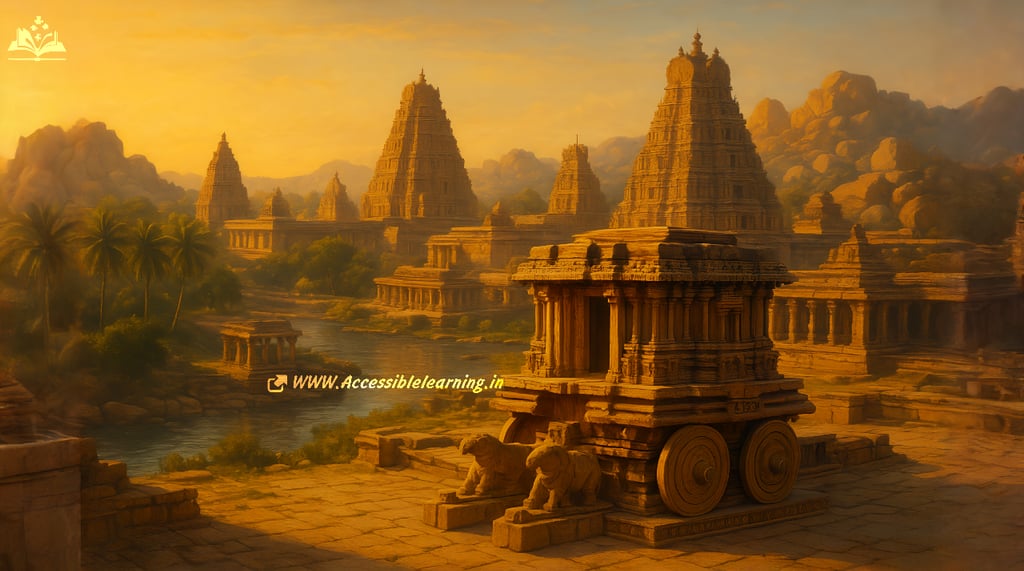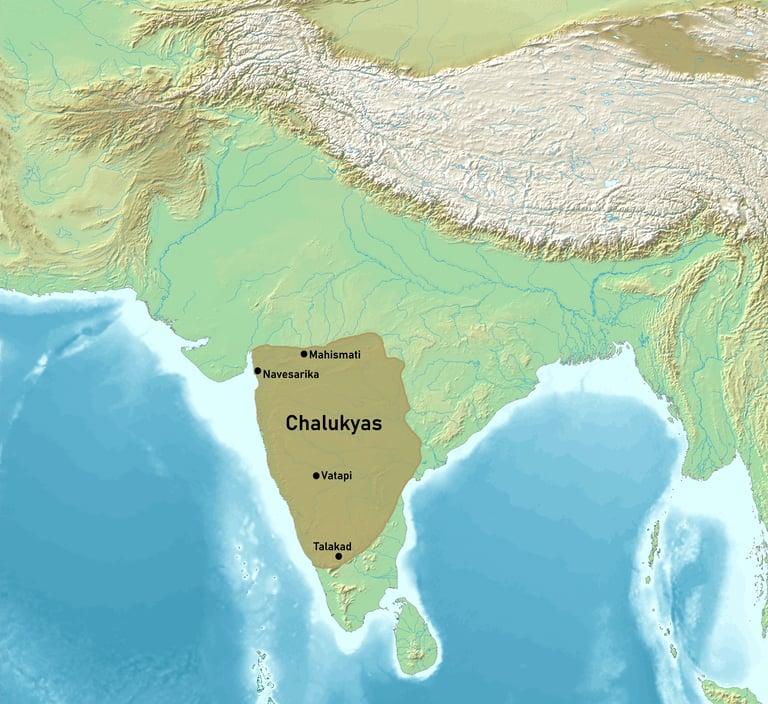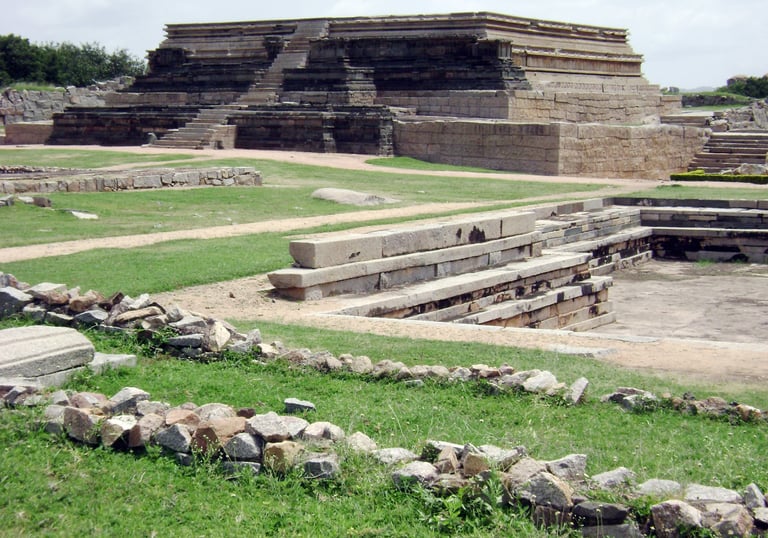
The Vijayanagara Empire: Complete Guide to South India's Greatest Hindu Kingdom
Discover the Vijayanagara Empire (1336-1565), South India's greatest Hindu kingdom. Explore Hampi's UNESCO heritage, architectural marvels, and historical legacy.
INDIAN HISTORYHISTORYEMPIRES/HISTORY
Keshav Jha
8/21/20259 min read


The Vijayanagara Empire stands as one of the most remarkable civilizations in Indian history, representing the last great Hindu kingdom of South India. Founded in 1336 and lasting until 1565, this magnificent empire was centered around its capital city of Vijayanagara, now known as Hampi, which has been designated as a UNESCO World Heritage Site. The empire's legacy continues to fascinate historians, archaeologists, and visitors from around the world, offering profound insights into medieval Indian politics, culture, and architecture.
The Vijayanagara Empire was established by brothers Harihara I and Bukka Raya in 1336, who ruled with an impressive military force of approximately one million soldiers. At its zenith, this South Indian empire controlled vast territories across the Deccan plateau, establishing itself as a formidable power that successfully resisted Muslim invasions for over two centuries.
Historical Foundation and Early Development
The Genesis of Vijayanagara: From Vision to Reality
The founding brothers, guided by their spiritual mentor Saint Vidyaranya, established the new city of Vidyanagar, or Vijayanagara, meaning "city of victory," on the southern banks of the Tungabhadra River. This strategic location would prove instrumental in the empire's military and commercial success, providing natural defenses while facilitating trade connections across peninsular India.
Archaeological evidence reveals that Vijayanagara was founded in the early 1300s and ruled over vast territories and populations for more than 200 years before being abandoned in 1565. The empire's establishment came during a crucial period when Hindu kingdoms were consolidating power to resist the expanding Delhi Sultanate and other Muslim powers in the region.
Pre-Imperial Settlement Patterns
Recent archaeological investigations have uncovered extensive evidence of pre-imperial settlement in the Vijayanagar area, including ash mounds, ancient settlements, megalithic cemeteries, temples, and rock art, demonstrating that the region had been densely populated long before the empire's creation. This historical continuity provided the empire with established trade routes, agricultural systems, and cultural foundations that contributed to its rapid growth and prosperity.
The Four Dynasties of Vijayanagara
The Vijayanagara Empire was ruled by four successive dynasties, each contributing unique elements to its political structure, military prowess, and cultural development:
Sangama Dynasty (1336-1485)
The founding dynasty established the empire's core territorial base and administrative systems. Under rulers like Harihara I, Bukka Raya I, and Deva Raya II, the empire expanded its boundaries and developed sophisticated governance structures that would define its character for centuries.
Saluva Dynasty (1485-1505)
This brief but significant dynasty focused on consolidating territorial gains and strengthening military capabilities. The Saluva rulers emphasized defensive fortifications and military reforms that prepared the empire for future challenges.
Tuluva Dynasty (1505-1570)
The most illustrious period of Vijayanagara history, the Tuluva dynasty reached the empire's greatest territorial extent and cultural achievements. Notable rulers included Krishna Deva Raya, widely regarded as the empire's greatest monarch, who expanded territories significantly and patronized arts, literature, and architecture.
Aravidu Dynasty (1570-1650)
The final dynasty attempted to restore imperial glory after the catastrophic Battle of Talikota in 1565 but faced insurmountable challenges from Deccan sultanates and changing political dynamics.


Political Administration and Governance Structure
Central Administration Framework
The Vijayanagara Empire developed a sophisticated administrative system that balanced centralized control with regional autonomy. The emperor, known as the Raya, held supreme authority but delegated significant powers to provincial governors and local administrators. This decentralized approach allowed the empire to effectively govern diverse territories with varying cultural, linguistic, and economic characteristics.
The empire's administrative structure included multiple tiers of governance, from the central court at Vijayanagara to provincial capitals, district headquarters, and village-level administration. This hierarchical system enabled efficient tax collection, military mobilization, and judicial administration across vast territories.
Military Organization and Strategy
The empire maintained a formidable military force of around one million soldiers, reflecting both its territorial ambitions and defensive requirements. The Vijayanagara military combined traditional Indian warfare tactics with innovative strategies adapted to counter evolving threats from Muslim armies equipped with gunpowder weapons.
The empire's military strength rested on several key elements: a professional standing army, fortified cities and strategic positions, naval capabilities for coastal defense, and diplomatic alliances with regional powers. Military commanders, known as Nayakas, controlled territorial divisions and provided military service in exchange for revenue assignments.
Economic Prosperity and Trade Networks
Commercial Excellence and International Trade
The Vijayanagara Empire achieved remarkable economic prosperity through strategic control of trade routes connecting the Indian Ocean with inland markets. Hampi served not only as the empire's political capital but also as one of the largest trading centers of its time, attracting merchants from across Asia, the Middle East, and even Europe.
The empire's economic strength derived from multiple sources: agricultural productivity in fertile river valleys, control of diamond mines and gold deposits, textile production and export, spice trade monopolies, and taxation of commercial activities. This diverse economic base provided the financial resources necessary to maintain large military forces and undertake ambitious architectural projects.
Agricultural Systems and Revenue Generation
The empire's agricultural prosperity relied on sophisticated irrigation systems, including tanks, canals, and wells that supported intensive cultivation. The administration implemented revenue systems that encouraged agricultural expansion while ensuring steady income for state operations. Land grants to temples and military commanders created incentives for agricultural development and local administration.
Religious and Cultural Achievements
Hindu Renaissance and Religious Patronage
The Vijayanagara Empire represented a significant Hindu renaissance in South India, patronizing traditional religious practices while demonstrating remarkable tolerance toward other faiths. The empire's patron saint, Vidyaranya, belonged to the Advaita order at Sringeri, and the Varaha (boar avatar of Vishnu) served as the empire's emblem. This religious identity provided legitimacy and cultural unity while distinguishing the empire from Muslim powers in the region.
The empire supported thousands of temples, monasteries, and religious institutions, contributing to the preservation and development of Hindu philosophical traditions, ritual practices, and artistic expressions. Religious festivals, pilgrimages, and scholarly debates flourished under imperial patronage, creating a vibrant cultural atmosphere that attracted intellectuals and artists from across India.
Architectural Innovations and Artistic Legacy
Vijayanagara architecture represents a distinctive synthesis of various South Indian architectural traditions, creating innovative building styles that influenced regional development for centuries. The empire's architects developed new approaches to temple construction, palace design, and urban planning that reflected both practical requirements and aesthetic aspirations.
The architectural legacy includes magnificent temple complexes with intricate sculptural programs, royal palaces demonstrating sophisticated engineering, fortification systems incorporating natural terrain features, and urban infrastructure supporting large populations. These achievements continue to inspire architects and artists while providing valuable insights into medieval Indian building techniques and aesthetic preferences.
Archaeological Significance and Modern Research
Hampi as a UNESCO World Heritage Site
Hampi, designated as a UNESCO World Heritage Site, represents one of the most beautiful and evocative historical sites in South India, serving as the austere yet grandiose last capital of the great Hindu Kingdom of Vijayanagar. The site contains extensive ruins that provide unprecedented insights into medieval Indian urban planning, architecture, and daily life.
The Vijayanagar Research Project has documented more than 33,000 cultural resources within approximately 11 square kilometers, demonstrating the site's exceptional archaeological significance. This comprehensive documentation effort continues to reveal new information about the empire's social organization, economic activities, and cultural practices.
Recent Archaeological Discoveries and Research
Recent archaeological excavations have uncovered an "Islamic Quarter" located near the "Royal Quarter," indicating the multicultural character of the imperial capital and the presence of Central Asian nobles from Timurid kingdoms. These discoveries challenge earlier assumptions about religious and cultural segregation within the empire, revealing a more complex and inclusive social structure.
Contemporary archaeological research employs advanced techniques, including ground-penetrating radar, satellite imagery analysis, and digital mapping, to uncover hidden structures and understand settlement patterns. These modern approaches continue to generate new insights into the empire's urban organization, defensive systems, and daily life practices.

The Battle of Talikota and Imperial Decline
The Catastrophic End of an Era
The year 1565 marked a turning point in South Indian history with the Battle of Talikota, where a coalition of Deccan sultanates decisively defeated the Vijayanagara forces. Following this defeat, the magnificent capital city was pillaged and abandoned, ending over two centuries of imperial glory. The battle's aftermath resulted in the systematic destruction of palaces, temples, and administrative buildings, leaving behind the ruins that fascinate visitors today.
The empire's decline resulted from multiple factors: internal succession disputes weakening central authority, technological disadvantages against gunpowder-equipped armies, economic strain from prolonged military campaigns, and the formation of powerful enemy coalitions. Despite attempts at restoration by the Aravidu dynasty, the empire never regained its former territorial extent or political influence.
Legacy and Historical Impact
The Vijayanagara Empire's legacy extends far beyond its political boundaries and temporal existence. The empire's administrative innovations influenced subsequent South Indian kingdoms, its architectural achievements continue to inspire contemporary designers, its cultural patronage preserved important Hindu traditions, and its commercial networks established trade patterns that persisted for centuries.
Tourism and Cultural Heritage Management
Modern Hampi: Balancing Preservation and Access
Contemporary Hampi attracts over 700,000 tourists annually, transforming the ancient site into a major cultural heritage destination. This popularity presents both opportunities and challenges for site management, requiring a careful balance between public access and heritage preservation.
The Archaeological Survey of India, in collaboration with international organizations, implements comprehensive conservation strategies that protect structural integrity while enabling educational and cultural activities. These efforts include restoration of damaged monuments, development of visitor infrastructure, and implementation of sustainable tourism practices.
Heritage Tourism and Economic Impact
Heritage tourism at Hampi generates significant economic benefits for local communities while promoting cultural awareness and historical education. The site serves as a model for heritage tourism development in India, demonstrating how archaeological sites can contribute to regional economic development while preserving historical authenticity.
Tourism activities include guided historical tours, cultural performances, educational programs, and artisan workshops that showcase traditional crafts and techniques. These initiatives provide livelihood opportunities for local residents while enhancing visitor experiences and cultural understanding.
The Vijayanagara Empire represents one of the most significant chapters in Indian history, demonstrating the remarkable achievements possible through effective governance, military strength, economic prosperity, and cultural patronage. Despite being abandoned in 1565 after more than 200 years of rule over vast territories and populations, the empire's influence continues to resonate through its architectural legacy, administrative innovations, and cultural contributions.
The empire's story offers valuable lessons about the dynamics of medieval Indian politics, the importance of adaptability in governance, and the enduring power of cultural identity. Modern India continues to draw inspiration from the Vijayanagara model of inclusive governance, economic development, and cultural preservation.
The mysterious legacy of the Vijayanagara Empire, including legends of hidden treasure vaults and sealed chambers beneath Hampi, continues to fascinate treasure seekers and historians alike. Whether pursuing archaeological discoveries, architectural appreciation, or historical understanding, the Vijayanagara Empire remains a source of endless fascination and learning.
The preservation and study of Hampi as a UNESCO World Heritage Site ensures that future generations will continue to benefit from the empire's remarkable legacy, while ongoing research promises to reveal additional secrets about this extraordinary civilization that once dominated South India and influenced the course of Indian history.


FAQ's
Q: What was the Vijayanagara Empire known for?
The Vijayanagara Empire was renowned for its military prowess, economic prosperity, architectural achievements, and role as the last great Hindu kingdom of South India. The empire successfully resisted Muslim invasions for over two centuries while fostering remarkable cultural and artistic developments.
Q: Who founded the Vijayanagara Empire, and when?
The Vijayanagara Empire was founded by brothers Harihara I and Bukka Raya in 1336, under the spiritual guidance of Saint Vidyaranya. These founding rulers established their capital on the banks of the Tungabhadra River in present-day Karnataka.
Q: What caused the fall of the Vijayanagara Empire?
The empire's decline culminated in the Battle of Talikota in 1565, where a coalition of Deccan sultanates defeated the Vijayanagara forces. Contributing factors included internal succession disputes, technological disadvantages, economic strain, and the formation of powerful enemy alliances.
Q: What is the significance of Hampi today?
Hampi, the former capital of the Vijayanagara Empire, is now a UNESCO World Heritage Site in Karnataka, attracting hundreds of thousands of visitors annually. The site contains extensive archaeological remains that provide invaluable insights into medieval Indian civilization.
Q: How large was the Vijayanagara Empire at its peak?
At its zenith during the 16th century, the Vijayanagara Empire controlled most of peninsular India south of the Krishna River, extending from the Arabian Sea to the Bay of Bengal. The empire encompassed present-day Karnataka, Andhra Pradesh, Tamil Nadu, and parts of Kerala, Maharashtra, and Odisha.
Q: What architectural styles did the empire develop?
Vijayanagara architecture represented a unique synthesis of Dravidian, Indo-Islamic, and regional building traditions. The empire's architects developed distinctive temple designs, palace complexes, and fortification systems that influenced South Indian architecture for centuries.
Q: What role did religion play in the empire?
The empire strongly supported Hindu traditions, with Vidyaranya from the Advaita order at Sringeri serving as patron saint and the Varaha (boar avatar of Vishnu) as the imperial emblem. However, the empire also demonstrated religious tolerance, as evidenced by the presence of Islamic quarters within the capital.
Q: What can visitors see at Hampi today?
Visitors to Hampi can explore extensive archaeological remains, including the Virupaksha Temple (still active), royal palaces, administrative buildings, market areas, fortifications, and residential quarters. The site contains over 33,000 documented cultural resources within approximately 11 square kilometers.
Q: How did the empire contribute to Indian culture?
The Vijayanagara Empire played a crucial role in preserving and developing Hindu cultural traditions during a period of significant Muslim expansion. The empire patronized literature, arts, music, dance, and religious practices while fostering a cultural renaissance that influenced South Indian civilization profoundly.
Q: What modern research is being conducted at the site?
Contemporary research at Hampi employs advanced archaeological techniques, including satellite imaging, ground-penetrating radar, and digital documentation, to uncover new structures and understand settlement patterns. International collaboration continues to generate new insights into the empire's social organization and daily life practices.
Subscribe to our newsletter
All © Copyright reserved by Accessible-Learning
| Terms & Conditions
Knowledge is power. Learn with Us. 📚


